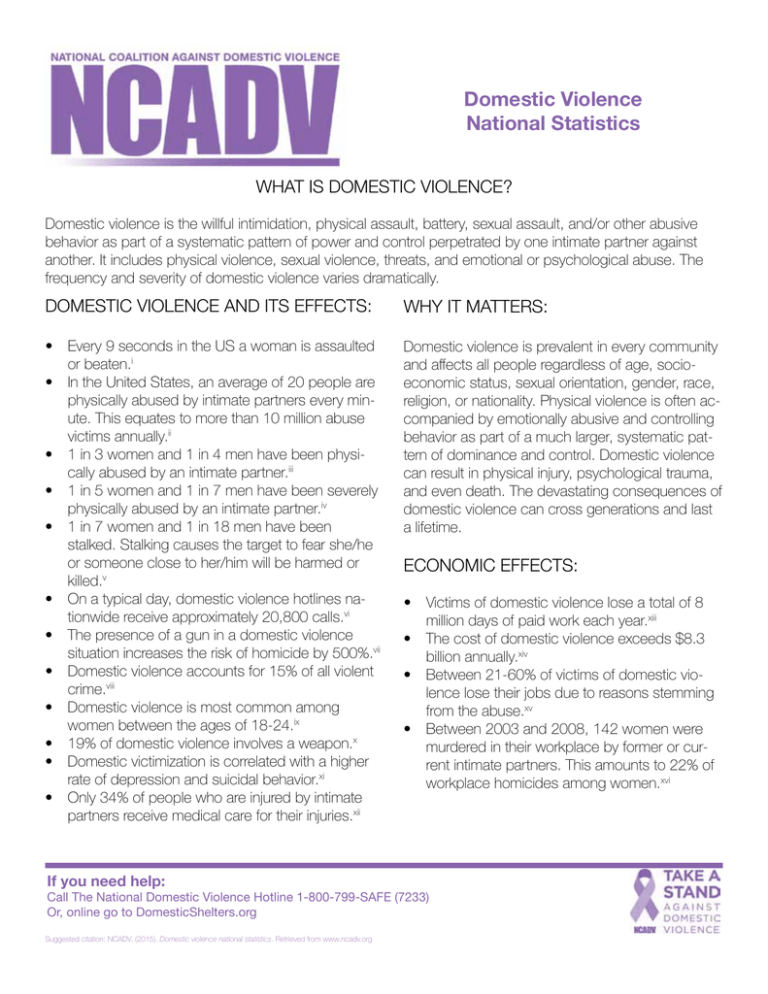
Domestic Violence
National Statistics
WHAT IS DOMESTIC VIOLENCE?
Domestic violence is the willful intimidation, physical assault, battery, sexual assault, and/or other abusive
behavior as part of a systematic pattern of power and control perpetrated by one intimate partner against
another. It includes physical violence, sexual violence, threats, and emotional or psychological abuse. The
frequency and severity of domestic violence varies dramatically.
DOMESTIC VIOLENCE AND ITS EFFECTS:
WHY IT MATTERS:
• Every 9 seconds in the US a woman is assaulted
or beaten.i
• In the United States, an average of 20 people are
physically abused by intimate partners every minute. This equates to more than 10 million abuse
victims annually.ii
• 1 in 3 women and 1 in 4 men have been physically abused by an intimate partner.iii
• 1 in 5 women and 1 in 7 men have been severely
physically abused by an intimate partner.iv
• 1 in 7 women and 1 in 18 men have been
stalked. Stalking causes the target to fear she/he
or someone close to her/him will be harmed or
killed.v
• On a typical day, domestic violence hotlines nationwide receive approximately 20,800 calls.vi
• The presence of a gun in a domestic violence
situation increases the risk of homicide by 500%.vii
• Domestic violence accounts for 15% of all violent
crime.viii
• Domestic violence is most common among
women between the ages of 18-24.ix
• 19% of domestic violence involves a weapon.x
• Domestic victimization is correlated with a higher
rate of depression and suicidal behavior.xi
• Only 34% of people who are injured by intimate
partners receive medical care for their injuries.xii
Domestic violence is prevalent in every community
and affects all people regardless of age, socioeconomic status, sexual orientation, gender, race,
religion, or nationality. Physical violence is often accompanied by emotionally abusive and controlling
behavior as part of a much larger, systematic pattern of dominance and control. Domestic violence
can result in physical injury, psychological trauma,
and even death. The devastating consequences of
domestic violence can cross generations and last
a lifetime.
If you need help:
ECONOMIC EFFECTS:
• Victims of domestic violence lose a total of 8
million days of paid work each year.xiii
• The cost of domestic violence exceeds $8.3
billion annually.xiv
• Between 21-60% of victims of domestic violence lose their jobs due to reasons stemming
from the abuse.xv
• Between 2003 and 2008, 142 women were
murdered in their workplace by former or current intimate partners. This amounts to 22% of
workplace homicides among women.xvi
Call The National Domestic Violence Hotline 1-800-799-SAFE (7233)
Or, online go to DomesticShelters.org
Suggested citation: NCADV. (2015). Domestic violence national statistics. Retrieved from www.ncadv.org
Domestic Violence
National Statistics
WHY DO PEOPLE STAY IN ABUSIVE RELATIONSHIPS?
One of the most common questions people ask about victims of domestic violence is, “Why don’t they just
leave?” People stay in abusive relationships for a variety of reasons including:
• The victim fears the abuser’s violent behavior will escalate if (s)he tries to leave.
• The abuser has threatened to kill the victim, the victim’s family, friends, pets, children and/or himself/herself.
• The victim loves his/her abuser and believes (s)he will change.
• The victim believes abuse is a normal part of a relationship.
• The victim is financially dependent on the abuser.
• The abuser has threatened to take the victim’s children away if (s)he leaves.
• The victim wants her/his children to have two parents.
• The victim’s religious and/or cultural beliefs preclude him/her from leaving.
• The victim has low self-esteem and believes (s)he is to blame for the abuse.
• The victim is embarrassed to let others know (s)he has been abused.
• The victim has nowhere to go if (s)he leaves.
• The victim fears retribution from the abuser’s friends and/or family.
• For more information, visit www.ncadv.org.
Sources:
i
Bachman, R. & Saltzman, E. (1995). Violence against women: Estimates from the redesigned survey. Retrieved from http://www.bjs.gov/content/pub/pdf/FEMVIED.PDF
ii
Black, M.C., Basile, K.C., Breiding, M.J., Smith, S.G., Walters, M.L., Merrick, M.T., Chen, J. & Stevens, M. (2011). The national intimate partner and sexual violence survey: 2010 summary report. Retrieved from http://www.cdc.gov/violenceprevention/pdf/nisvs_report2010-a.pdf.
iii
Ibid.
iv
Ibid.
v
Ibid.
vi
National Network to End Domestic Violence (2015). ’14 domestic violence counts national summary. Retrieved from http://nnedv.org/downloads/Census/DVCounts2014/DVCounts14_NatlSummary_Color-2.pdf.
vii
Campbell, J.C., Webster, D., Koziol-McLain, J., Block, C., Campbell, D., Curry, M. A., Gary, F., Glass, N., McFarlane, J., Sachs, C., Sharps, P., Ulrich, Y., Wilt,
S., Manganello, J., Xu, X., Schollenberger, J., Frye, V. & Lauphon, K. (2003). Risk factors for femicide in abusive relationships: Results from a multisite case control
study. American Journal of Public Health, 93(7), 1089-1097.
viii
Truman, J. L. & Morgan, R. E. (2014). Nonfatal domestic violence, 2003-2012. Retrieved from http://www.bjs.gov/content/pub/pdf/ndv0312.pdf.
ix
Ibid.
x
Ibid.
xi
Ibid.
xii
Truman, J. L. & Morgan, R. E. (2014). Nonfatal domestic violence, 2003-2012. Retrieved from http://www.bjs.gov/content/pub/pdf/ndv0312.pdf.
xiii
Rothman, E., Hathaway, J., Stidsen, A. & de Vries, H. (2007). How employment helps female victims of intimate partner abuse: A qualitative study. Journal of Occupational Health Psychology, 12(2), 136-143. doi: 10.1037/1076-8998.12.2.136.
xiv
Ibid.
xv
Ibid.
xvi
Finkelhor, D., Turner, H., Ormrod, R. & Hamby, S. (2011). Children’s exposure to intimate partner violence and other family violence. Retrieved from https://www.
ncjrs.gov/pdffiles1/ojjdp/232272.pdf.
If you need help:
Call The National Domestic Violence Hotline 1-800-799-SAFE (7233)
Or, online go to DomesticShelters.org
Suggested citation: NCADV. (2015). Domestic violence national statistics. Retrieved from www.ncadv.org

